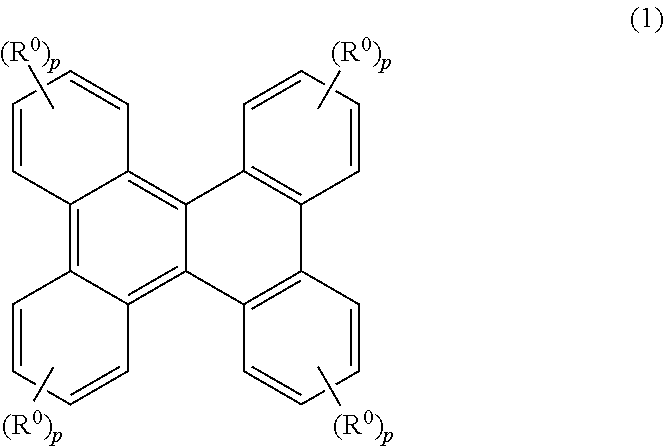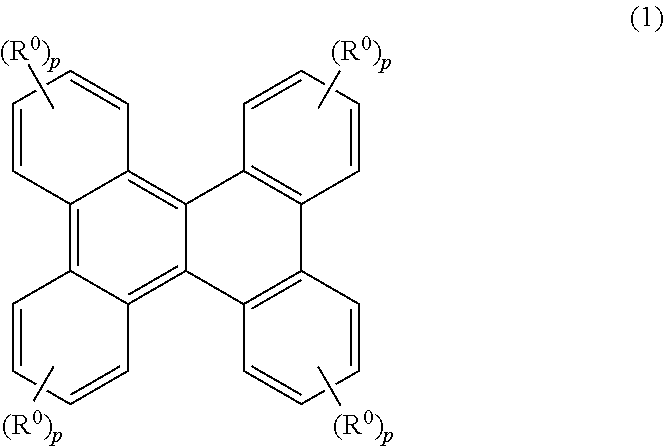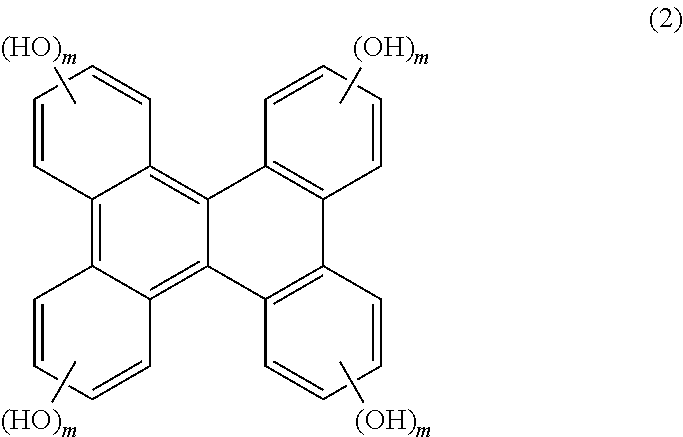Resist material, resist composition and method for forming resist pattern
a resist material and composition technology, applied in the field of resist materials, can solve the problems of reducing yield, difficult control of pattern dimension, limitation of miniaturization with lithography using a conventional polymer based resist material, etc., and achieves excellent heat resistance and etching resistance, high sensitivity, and high solubility
- Summary
- Abstract
- Description
- Claims
- Application Information
AI Technical Summary
Benefits of technology
Problems solved by technology
Method used
Image
Examples
examples
[0242]The present embodiment will be more specifically described with reference to examples below. However, the present embodiment is not limited to these examples. Hereinafter, the structure of a compound in synthesis examples and comparative examples was confirmed by 1H-NMR measurement.
[Molecular Weight]
[0243]A molecular weight was measured using Acquity UPLC / MALDI-Synapt HDMS manufactured by Water Corporation according to LC-MS analysis.
[Polystyrene Based Molecular Weight]
[0244]A polystyrene based weight average molecular weight (Mw) and number average molecular weight (Mn) were determined according to gel permeation chromatography (GPC) analysis. Dispersity (Mw / Mn) was determined.
[0245]Apparatus: Shodex model GPC-101 (manufactured by Showa Denko K.K.)
[0246]Column: KF-80M×3
[0247]Eluent: 1 mL / min THF
[0248]Temperature: 40° C.
(Synthesis Example 1) Synthesis of Dibenzochrysene (DBC)
[0249]On the basis of the description of Example 1 in Japanese Patent Application Laid-Open No. 2013-22...
examples 1 to 3
[0254]Resist compositions corresponding to Examples 1 to 3 were each prepared using the above compounds or resins obtained in Synthesis Examples 1 to 3, and the following materials according to the composition shown in Table 1.
[0255]Acid generating agent: di-t-butyl diphenyl iodonium nonafluoromethanesulfonate (DTDPI) manufactured by Midori Kagaku Co., Ltd.
[0256]Crosslinking agent: NIKALAC MX270 (NIKALAC) manufactured by Sanwa Chemical Co., Ltd.
[0257]Organic solvent: propylene glycol monomethyl ether acetate (PGMEA)
[0258]Next, a silicon substrate was spin coated with each of the resist compositions of Examples 1 to 3, and then baked at 110° C. for 90 seconds to respectively form resist films with a film thickness of 200 nm. Subsequently, these resist films were evaluated for their etching resistance by an etching test under conditions shown below. The evaluation results are shown in Table 1.
[Etching Test]
[0259]Etching apparatus: RIE-10NR manufactured by SAMCO Inc.
[0260]Output: 50 W
[...
synthesis example 15
(Synthesis Example 15) Synthesis of HDBC-4-BOC
[0284]In a container (internal capacity: 200 mL) equipped with a stirrer, a condenser tube, and a burette, 4.9 g (12.5 mmol) of the compound (HDBC-4) obtained in Synthesis Example 2 and 5.5 g (25 mmol) of di-t-butyl dicarbonate (manufactured by Sigma-Aldrich Corp.) were added to 100 mL of acetone, then 3.45 g (25 mmol) of potassium carbonate (manufactured by Sigma-Aldrich Corp.) was added, and the contents were stirred at 20° C. for 6 hours to perform reaction and obtain a reaction solution. Next, the reaction solution was concentrated. The reaction product was precipitated by the addition of 100 g of pure water to the concentrate. After cooling to room temperature, the solid matter was separated by filtration.
[0285]The obtained solid matter was filtered, dried, and then separated and purified by column chromatography to obtain 2 g of the objective compound (HDBC-4-BOC) represented by the formula (HDBC-4-BOC) shown below.
[0286]As a resul...
PUM
| Property | Measurement | Unit |
|---|---|---|
| Reactivity | aaaaa | aaaaa |
Abstract
Description
Claims
Application Information
 Login to View More
Login to View More - R&D
- Intellectual Property
- Life Sciences
- Materials
- Tech Scout
- Unparalleled Data Quality
- Higher Quality Content
- 60% Fewer Hallucinations
Browse by: Latest US Patents, China's latest patents, Technical Efficacy Thesaurus, Application Domain, Technology Topic, Popular Technical Reports.
© 2025 PatSnap. All rights reserved.Legal|Privacy policy|Modern Slavery Act Transparency Statement|Sitemap|About US| Contact US: help@patsnap.com



